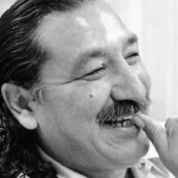If you’ve been following the protests against the construction of the Dakota Access pipeline, you’ve probably seen tons of buttons, T-shirts, and banners with his name emblazoned on them, calling for his release.

His name is Leonard Peltier and tomorrow marks 41 years since he was arrested by the U.S. federal government, held in prison now for 41 years.
RELATED:
Leonard Peltier Officially Denied Clemency by Obama
Peltier, a member of the American Indian Movement is a revolutionary Native American leader who is currently serving two consecutive life terms in federal prison.
On June 26, 1975, two undercover FBI agents illegally entered the Pine Ridge Indian Reservation, with over 150 law enforcement officers surrounding its perimeters. Shots were heard and a shoot-out ensued, resulting in the death of the two FBI agents and one Oglala Lakota tribe member, witnesses said. Joseph Stuntz, the tribe member who was killed, was shot in the head by a sniper bullet. His death has never been investigated.
On Feb. 6, 1976, Peltier was arrested in Canada, eventually being extradited to the U.S. a year later. U.S. courts claim a former girlfriend of his by the name of Myrtle Poor Bear signed witness statements claiming she personally saw him shoot the two FBI agents. Poor Bear would eventually recant her statements.
The FBI also claimed that three young members of the Oglala Lakota tribe allegedly saw Peltier murder the agents. They later admitted, however, that they were forced to testify against him by the FBI and that he was not the shooter. Moreover, government ballistics experts claimed that a bullet casing discovered near the agents’ bodies matched one of Peltier’s guns, intentionally withholding the fact that previous ballistics exams proved otherwise.
It’s been 41 years since the AIM leader was arrested and now his health is quickly deteriorating — Peltier has diabetes and suffers from a heart condition that raises his blood pressure to dangerous levels.
Last month, many believed Peltier would be granted clemency by outgoing President Barack Obama. Fellow political prisoner and Puerto Rican independence hero Oscar Lopez Rivera’s sentence was commuted by Obama. But not a word was said about Peltier, except to confirm that he would not be freed. This came a month after Native American and environmental activists celebrated Obama’s decision to halt construction on the Dakota Access pipeline weeks before leaving office.
But now that President Trump is calling for renewed construction of the pipeline and has not communicated any attempt to release Peltier, Native American activists across the country are again gearing up for battle in defense of Standing Rock and Peltier.
Last week, North Dakota police arrested 76 people at Standing Rock as the Army Corp of Engineers cleared the way for the Dakota Access Pipeline to continue construction through Native American land.
Lydia Ponce, head of logistics and press for AIM Southern California, believes the struggle to defend Standing Rock and Peltier are interconnected.
“It’s almost impossible not to mention the two in the same sentence,” Ponce told teleSUR in an interview.
“It's the same struggle from over 40 years ago. Protecting land and humans from extraction and violence that ruin us. It's the same mantra, chant, prayer, and slogan.”
RELATED:
From Mumia to Peltier, US Political Prisoners Still Locked Up
Ponce, an Indigenous Mayo and Quechua activist based in Los Angeles, is in the process of sending a delegation of 12 people to Standing Rock. The delegation is bringing supplies like face masks, goggles, medical gloves, gauze, and food stuffs to those who are there.
Ponce believes that Peltier’s struggle for Native American liberation is inspiring younger generations of water and land defenders whose first experience with activism have been the #NoDAPL protests.
“He’s teaching everyone there that you can persevere every day, you continue to create, to cultivate your mind and spirit. And no matter how you're attacked and forced to live in deplorable conditions, you find a way to make your spirit rise,” she said.
“Your mind, heart and spirit can still connect with those around you. You continue to pray.”
Charles Hancock, co-founder of the Native American Rights Movement, is also organizing support for Standing Rock and Peltier. Hancock, who is of Monacan and Tuscarora heritage, regularly meets with other activists in his native Raleigh, North Carolina to disseminate information about issues facing Native Americans.
His organization provides a platform for Native Americans living in isolated rural areas to discuss and organize together, in person and over the internet.
For Hancock, Peltier follows a long line of Native American leaders who have resisted governments and corporations exploiting Indigenous lands.
“There’s over 500 years of resistance and he's just a part of that,” he said. “Our people have pictures of Peltier right next to Metacomet. He’s another leader in the Native American community that has stood up for what’s right. Most of us see him in that way.”
Metacomet was a Wampanoag chief who led mass uprisings against English puritans colonizing present-day Connecticut, Rhode Island and Massachusetts.
Hancock also believes that Peltier’s struggle is inspiring new waves of water defenders fighting Trump’s treatment of the environment.
“Hundreds of other resistance movements like Standing Rock that are inspired by Peltier are springing up,” he said.
“Both are springboards for larger and more powerful actions that are to come. People are primed and ready. It's won’t be the last time there's rebellion on these lands.”